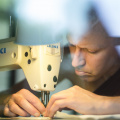Home /
After daily chores and the midday meal, Dhammavaro sews his three robes. The “triple set”consists of the sabong - a robe worn at the waist; the jiworn - an outer robe covering the body; and the sanghati - a double-layered robe for formal occasions.
954/4913

- Created on
- Friday 8 May 2020
- Posted on
- Friday 4 September 2020
- Dimensions
- 5809*3872
- File
- 20200904_dhammavaro_final_24.jpg
- Filesize
- 10067 KB
- Albums
- Visits
- 1389

